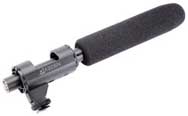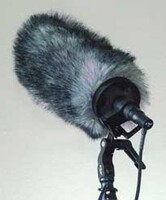![]() Before we get into a discussion of windscreens, a preliminary word about wind noise. There are two types of wind noise that will affect your soundtrack: acoustic wind noise and contact wind noise. Acoustic wind noise is sound of the wind blowing in the environment. It may be the howling that the wind makes blowing through trees and between buildings. It is a form of ambiance, just like traffic noise. Because it is a generated background noise in our environment, it cannot be controlled by a windscreen.
Before we get into a discussion of windscreens, a preliminary word about wind noise. There are two types of wind noise that will affect your soundtrack: acoustic wind noise and contact wind noise. Acoustic wind noise is sound of the wind blowing in the environment. It may be the howling that the wind makes blowing through trees and between buildings. It is a form of ambiance, just like traffic noise. Because it is a generated background noise in our environment, it cannot be controlled by a windscreen.
Rolling off or filtering out the low frequencies will help somewhat, but howling wind is made up of a lot of higher frequencies as well, so eliminating the bass is only a partial help.
The best way to eliminate acoustic wind noise is to closely mic the talent. Get the microphone in as close as you can get it, and then lower your mic gain (volume) so that dialogue dominates the soundtrack instead of background ambiance. That’s really about all that you can do.
Contact wind noise, on the other hand, is that blast of distortion and audio breakup caused from wind physically striking the sensitive diaphragm of the microphone capsule. We’ve all heard that sound when someone blows directly into a microphone.
The distortion created by contact wind noise cannot be fixed in post-production. It can only be chopped out along with the accompanying dialogue; and a new piece of dialogue cut in to replace it.
But contact wind noise can be prevented. That’s what a windscreen does.
 The simplest windscreens are known as pop filters (see right). Pop filters may be of either thin foam or metal mesh. Their purpose is not to defend against natural wind, but to block the exhalation from a performer, known in the industry as breath pops.
The simplest windscreens are known as pop filters (see right). Pop filters may be of either thin foam or metal mesh. Their purpose is not to defend against natural wind, but to block the exhalation from a performer, known in the industry as breath pops.
Pop filters don’t do much against real wind, but anything is better than nothing. Thicker foam windscreens will protect against light breezes, both indoors and out.
 At no time should a shotgun mic ever be used without at least a foam windscreen, such as this one on an Azden SGM-1000 (see left). Even indoors, the mic can encounter moving air (wind) that would cause breakup. Air from heating/cooling systems, open passageways, and especially from being swung on the boompole are all indoor wind hazards for the highly sensitive mics that our industry uses.
At no time should a shotgun mic ever be used without at least a foam windscreen, such as this one on an Azden SGM-1000 (see left). Even indoors, the mic can encounter moving air (wind) that would cause breakup. Air from heating/cooling systems, open passageways, and especially from being swung on the boompole are all indoor wind hazards for the highly sensitive mics that our industry uses.
Another good reason to always use a foam windscreen is to physically protect the microphone from dust and accidental impact. As careful as we all try to be, boompoles eventually have a habit of sliding down a wall and striking the floor. Without the padded protection of the foam windscreen, the poor mics could easily be damaged.
Outdoors, a foam windscreen will provide only minimal defense against wind noise. Foam will suffice for the less sensitive electret condenser (ENG-type) shotguns such as the Sennheiser ME66 and Audio Technica AT897, but the highly sensitive true condenser shotgun mics such as the Sennheiser MKH60/70 and Audio Technica BP4071/4073 require beefier wind protection.
 K-Tek and Rycote both make products that are an affordable compromise between the full, pistol-grip shockmount/zeppelin windscreens and just plain foam. The Rycote Softie and the K-Tek Fuzzy (see right) are relatively compact, foam shell windscreens with an integral furry outer covering that slips over a mic in lieu of the foam windscreen. Use a standard shockmount to hold the mic.
K-Tek and Rycote both make products that are an affordable compromise between the full, pistol-grip shockmount/zeppelin windscreens and just plain foam. The Rycote Softie and the K-Tek Fuzzy (see right) are relatively compact, foam shell windscreens with an integral furry outer covering that slips over a mic in lieu of the foam windscreen. Use a standard shockmount to hold the mic.
These manufacturers also offer a variation of their furry, softie, or fuzzy windscreens (note that these descriptives are copyrighted trademarks) that combine some sort of threaded mounting yoke and mic support with the windscreen. This can be very convenient if you tend to always deploy the mic with these heavier duty windscreens, but are not as good of a choice if you routinely switch between a foam screen for interiors and a furry screen for exteriors.
In a pinch, you can improve upon a foam windscreen by wrapping it with several layers of cheesecloth, and then containing the whole affair within a sweat sock. If you are faced with a real windstorm, anything goes: terry cloth towels, chopped off sleeves from a sweatshirt, etc. Just so long as the covering is porous. WindTech offers a furry sheath that fits over many popular foam windscreens.
Windscreens work by providing a barrier against moving wind. We can define windscreens as single stage barriers, two-stage, and multi-stage.
The simple foam windscreen is an example of the single stage barrier. Moving air is slowed down by the porous foam before it can strike the mic element.
